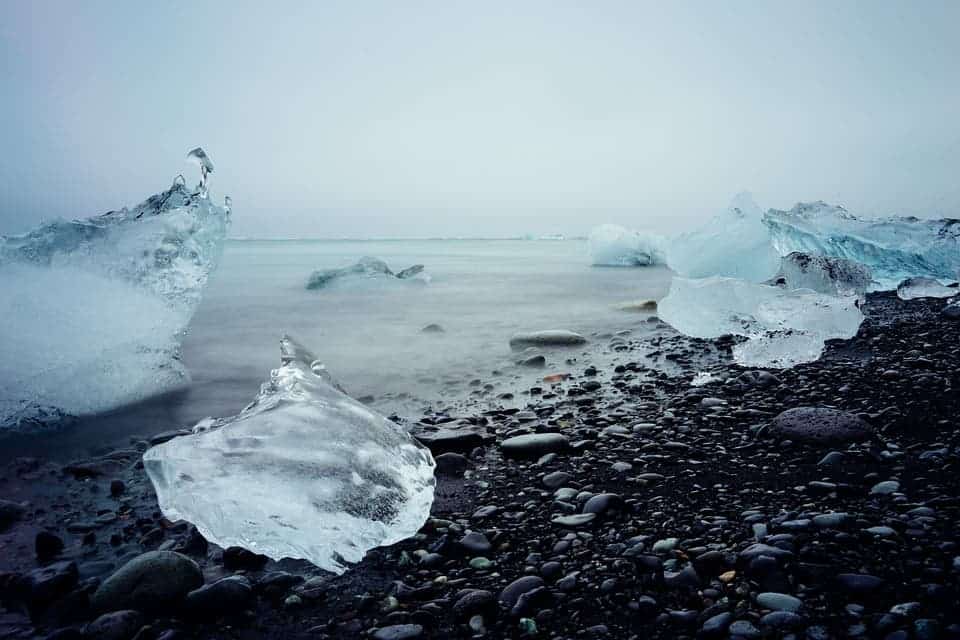Melting Arctic ice is already leaving its mark on the oceans.

In the frozen reaches of the North Atlantic, researchers have uncovered evidence of climate change already impacting ocean circulation. The discovery of unusual freshwater bodies at the ocean’s surface, most likely coming from melting glaciers and sea ice in Greenland or the Arctic is a worrying harbinger of larger disruptions yet to come.
But isn’t the ocean already made of water?
When you mix salt and water, the salt doesn’t just ‘melt’ in the water. It doesn’t dissolve and then its intact molecules flow alongside water molecules. Salt is an ionic mixture of a metallic atom and a non-metallic atom; in the case of table salt, those are Na, or sodium, and Cl, chlorine.
It’s ‘ionic’ because chlorine is hungry for electrons (it needs one to fill its outer layer and become stable), while sodium is partial to giving electrons (it needs to give one to strip its outer layer and become stable). So what brings and binds these two together is an electromagnetic reaction, in which sodium’s electron orbits both, making everyone kinda happier.
However, water is also electromagnetically polarized — it has a negative pole, where the oxygen atom sits, and a positive pole, where the two hydrogen atoms lay. When you mix salt with water, the Na-Cl bond breaks, the atoms (now referred to as ‘ions’) spread out through water molecules, and then satisfy their electromagnetic needs by cozying up to the ol’ H2O. If you freeze or boil the water, it separates from the salt.
In other words, salt water isn’t water with salt mixed in — it’s water that is chemically tied to the constituents of salt. Meaning it’s much denser than freshwater, so it sinks under it.
That’s why the infusion of meltwater is causing a problem in the North Atlantic: all this incoming freshwater stays at the surface of the ocean for much longer than the denser, saltwater used to do. This, in turn, could affect the natural convection processes in the area. Northbound water (which is warm, as it comes from the Equator) starts to sink as it cools and becomes denser. This body of water is then pushed below and makes its way south, goaded on by the second part of the currents that brought it to the Arctic.

Image credits Marilena Oltmanns, Johannes Karstensen & Jürgen Fischer / Nature.
The team used ocean moorings in the Irminger Sea (southeast of Greenland) to gather data on water circulation patterns in key convection sites in the area. The authors report that freshwater from melting glaciers and sea ice is already having a noteworthy effect convection patterns. The team doesn’t make any predictions regarding how this influence will develop in the future, or how fast it will do so, but they report that in 2010, 40% of melted freshwater stayed at the surface through winter and into the next year. It’s a huge quantity. Worse still, this freshwater can form a positive feedback loop — as more of it persists at surface level, it gets progressively easier for it to do so, meaning even more will persist.
“Until now, models have predicted something for the future,” study lead author Marilena Oltmanns told the Washington Post, “but it was something that seemed very distant. Now we saw with these observations that there is actually freshwater and that it is already affecting convection, and it delays convection quite a lot in some years.”
“It is possible that there is a threshold, that if there is a lot of freshwater that stays at the surface, and mixes with the new freshwater from the new summer, it suddenly doubles, or increases a lot, and the next winter, it’s a lot more difficult to break through.”
It has already been observed that Atlantic circulation (powered by convection currents) has been weaker than average, ever since 2008. While part of this effect has been credited to cyclical changes, the current findings are worrying because they show convection patterns can change much faster than we believed.
“There might be a threshold that is crossed, and it’s harder to get back to where we were before,” said Oltmanns. “It’s possible.”
The paper “Increased risk of a shutdown of ocean convection posed by warm North Atlantic summers” has been published in the journal Nature Climate Change.


